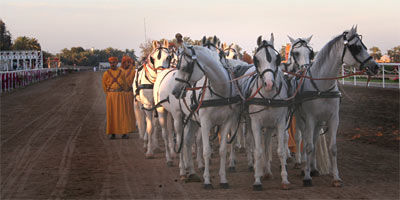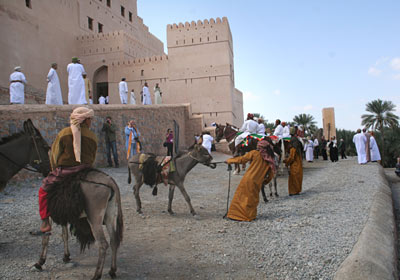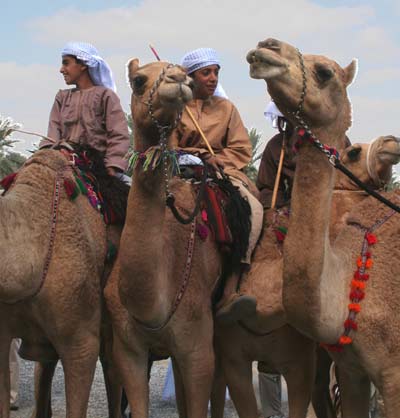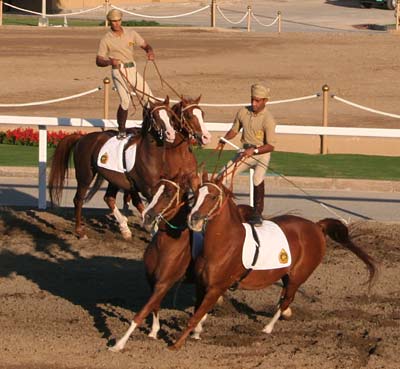| |
In 2009, the Sultanate of Oman invited WAHO delegates and guests to
Muscat and to tour this incredible country
WAHO in Oman in February 2009
A WAHO conference in a Middle Eastern country with a heritage of Arabian
horses and an Islamic respect for the breed is always a pleasure. An additional
privilege for delegates and guests at the Oman conference was a private
invitation to the Royal Stud of the ruler, Sultan Qaboos.
So after the official WAHO business in the capital, Muscat,was over we
flew down to the tiny resort of Salalah in the deep south, beside the
Indian Ocean.
Spread over lush acres behind
high walls in this oasis resort, the stud has
built up slowly over the past 20 years. Run by the Royal Cavalry and
breeding mostly race horses, the stables have enjoyed international
success and won praise for their stock. Here his young horses graze
under the tall palms, benefiting from the shade and the lush grass,
supplemented by alfalfa. |
|
 |
But the Sultan's real achievement is to re-establish racing stock in
a country that had lost almost all its indigenous Arabian horses. He has
brought in Arabian blood from many parts of the world in endeavours to
breed top quality horses.
 |
|
The afternoon parade of
racehorses and breeding stock showed WAHO visitors the wealth of
imported horses being bred from mostly French stallions like Manganate,
Cheri Bibi and the Sultan's own Saut du Loup, and the Russian Donchak,
with one or two rarer lines like the Tunisian mares - Cheikha and
18-year old Douja. |
But jaws dropped when, saving the best until last, the elegant and powerful
senior stallion Khallab (Kubinec x Dal) appeared. What a look-alike for
the AHS Premium stallion Sambist, but hardly surprising as they have the
same sire line through Balaton. These imposing Russian horses provide
not only height and bone, but an aura of majesty, totally suited to such
royal surroundings. I felt honoured to be allowed to have my photo taken
with him
as a souvenir to bring back to Gadebrook, home of Sambist.
The afternoon had started
with a parade of soldiers in both military and traditional dress,
and ended with a repeat performance, with a few additional stunts.
My favourite was the trick of making the horse lie flat and still,
so that it could be hidden behind a rock out of view of the enemy.
Then at a moment's command, the horse would be up and away with
the
rider on its back, either fleeing or entrapping the enemy in ambush. |
|
 Nakhal fort
Nakhal fort |
Then came a further treat - guests were asked to choose a horse to ride
it round the stud. The Aussies were not backward in coming forward - I
could name names and photos WERE taken, Kim - as each picked their mount.
To ride one of Sultan Qaboos' horses in Oman is a rare opportunity, especially
when followed by Eastern hospitality - tea, halwa and sweetmeats.
 |
|
The Sultan was a keen horseman in his youth and rode extensively.
Now he encourages young riders, male and female, through a programme
run by the Royal Cavalry. He has also replenished the Cavalry stables
with horses and ponies from all over the world and established the
Royal Horse Racing Club in the vibrant gardens of Madinat al Adiyat
in Seeb, near the capital, Muscat, in the north. But in the intimate
setting of the Salalah stud we were able to see the Sultan's own
vision for a successful racing stable, and we all appreciated the
chance to see the results.
|
Before we left Salalah the following morning, those WAHO guests who could
pull themselves away from the beach and the warm waters of the Gulf were
treated to the private stud of Sheikh Ayid bin Ahmad Shanfari. His staff
served us breakfast in the shade of the palm trees in beautiful gardens
surrounded by paddocks full of inquisitive and extremely healthy-looking
foals.
|
But we still had a country to discover - a country too vast to
see in the allotted 6 days. Somehow we managed to pack in a walk
on the beach at Ras al Jinz under a full moon to watch giant sea
turtles haul themselves out of the sea, dig nests in the sand with
their giant flippers and lay hundreds of eggs. Nearby, tiny hatchlings
emerged from their two-month incubation and headed for the moonlit
sea.
Another highlight was our trip into the Wahiba Sands for a session
of dune-bashing in 4 x 4s, with a night at Al Raha camp in the desert,
dancing to Arab music under the stars to the crackle of the camp
fire. On the return, we caught a glimpse of Bedouin nomads and their
racing camels, treasure worth at least as much as an Arabian horse.
|
|
 Sultan Qaboos stud. Cavalrymen in traditional
dishdashas need little excuse to show off their riding skills on
the Sultan's horses
Sultan Qaboos stud. Cavalrymen in traditional
dishdashas need little excuse to show off their riding skills on
the Sultan's horses |
| |
|
|
 Don't try this at home
Don't try this at home |
|
But the final onslaught - a hair-raising 5-hour off-road mountain
assault in the trusty 4 x 4 with the wheels on one side teetering
over a 1,000m precipice and the wing mirror on the other scraping
vertical rock - took us right into the primeval heart of Oman.
Copyright Anne Brown 2009
|
|